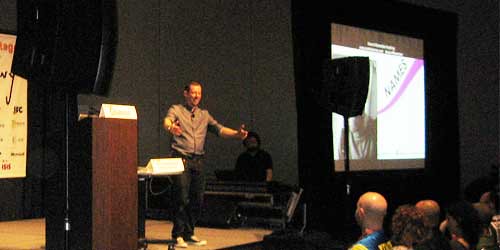
The UK’s Mark Channon, one of the world’s foremost experts on memory and mind mapping, presented at SXSW Interactive 2012 Monday, for one of the mini-sessions. Originally an actor, in 1995 he became the eighth person to win the title of Grand Master of Memory. To judge by the size of the crowd and the close attention they paid him, many attending SXSWi have memory issues – or maybe just want to do it better.
Channon’s technique makes it look easy. Using mind mapping, he links the facts needing to be remembered into a story with a great deal of sensory detail at every key point into a connected chain. He also uses lots of gestures to act out the key elements to help one remember key parts of the story, thus adding tactile-kinesthetic sensory input and taking advantage of that kind of memory.
The stories are not factual. They are simply a device used as a memory aid.
He illustrated with a story about Ben, a bear, wearing a furry coat, diving into a pool of warm honey, coming out with a dinosaur, putting on a baseball cap, picking up a big baseball bat, swinging and smashing the bat into a Ferrari driven by Tom Cruise who was smoking a huge cigar. Cruise snuffs the cigar out on the head of a bald man.
Okay, that was my own memory limits 24 hours later. So here’s the rest of the story: The bald-headed man is eating a big, sticky chocolate bar which is wrapped around by a slimy snake. The snake is drunk and is drinking a bottle of red wine.
Listening back, I find I missed a couple of details: The bear bounces up and down on a springboard before diving into the box (not pool) of honey. And it’s the dinosaur (not bear) that puts on the baseball cap and swings the baseball bat.
Channon asked for a volunteer to enumerate the entire list, and amazingly the guy did. The average person can remember just five to seven things at a time, and I fall in the average category. By my count, I remembered 12 details still the next day, and misremembered or omitted three.
The average person would have remembered anywhere from 33 percent to 46 percent of the items under normal conditions, according to widely accepted research on working memory, the more active part of memory. Remembering eighty percent of the items some twenty-four hours later is enough of a difference to sit up and take notice.
Imagine what one could do with more practice…
Check out this video of an interview of Mark Channon conducted in 2009 for SXTXState.com by a former student at Texas State University.
